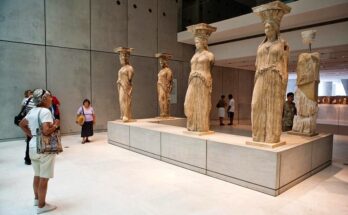In his epic work the Iliad, written around eighth century BC, Homer first introduces us to Andromache. According to Greek mythology, Andromache (in Greek pronounced Andromákhē) was the daughter of King Eetion, who ruled over Cicilian Thebe. Most notably, she is also the wife of Trojan Prince Hector.
Throughout history, many dramatists have revisited the tragic tale of Andromache, capturing her sorrow in a myriad of ways. In the Iliad, her husband, Hector, meets a brutal end at the hands of Achilles, who later drags Hector’s lifeless body around the walls of Troy behind his chariot.
Nonetheless, Andromache’s suffering doesn’t end there. She also has to endure the tragic death of her young son Astyanax, who is thrown over Troy‘s walls. Afterwards, she is given to the son of Achilles as a captive of war.
Among the dramatists who have attempted to narrate Andromache’s tale after the fall of Troy are Euripides, Virgil, and, more recently, Jean Racine.
Andromache, as depicted by Euripides
Euripides’ Athenian tragedy Andromache, first performed in fourth century BC, depicts the life of Andromache as a slave in captivity, years after the happenings of the Trojan War. Now the property of Achilles’ son Neoptolemus (in some versions also called Pyrrhus), she accompanies him in Epirus, where he is king, and ends up having a child, Molossus, with him.
However, Neoptolemus is married to another—Hermione, the daughter of Helen. Consumed by her flaming jealousy, Hermione turns against Andromache, resentful that she cannot bear any children of her own. With the help of Menelaus, her father, she plots to assassinate both Andromache and Molossus, but, at the last moment, Peleus intervenes and saves them.
After Neoptolemus’ death, Andromache’s luck improves. She marries Helenus, Hector’s brother, and becomes queen of Epirus. In Euripides’ play, Andromache is depicted as a woman who deeply mourns her lost husband. She is a widow and, as such, a tragic figure. She embodies the faithful wife honoring Hector’s memory but also the devoted mother, striving to save her son’s life.
Andromache in Virgil’s The Aeneid
Andromache’s fame at some point crossed the boundaries of Greece, as her character also inspired the Roman poet Virgil. His work The Aeneid, written from 30 to 19 B.C., features Andromache in Book Three.
Specifically, she appears as a character in the Buthrotum episode. There, following Pyrrhus’ death, Andromache is portrayed as wife to Helenus, who has control over the realm of Epirus. Like Euripides, Virgil paints a portrait of Andromache as a wife who remains faithful to the memory of her dead husband above all.
In an analysis of Aeneid III, Richard E. Grimm notes that Virgil makes it seem as if “Andromache regards herself still as the wife of the dead Hector.” When Aeneas first sees her, she’s offering sacrifice at Hector’s cenotaph. Virgil utilizes her character to attribute a more emotional hue to this scenario and upholds the image of Andromache as encountered in the Iliad.

Jean Racine’s Andromaque
With Racine, Andromache’s story gained prominence among French bourgeoisie. Guided by the Classicism movement, during which writers looked to antiquity for inspiration, Racine used the aftermath of the Trojan War as the foundation for his tragedy, Andromaque.
Andromaque was first performed in 1667 before the court of Louis XIV. In its composition, Racine was deeply influenced by the works of Euripides and Virgil on the Trojan princess. Set in Epirus, Racine’s tragedy depicts Andromache as a captive of Pyrrhus, who is deeply in love with her. However, there is one important twist. Andromache’s son with Hector, Astyanax, isn’t dead but also a captive of the king of Epirus.
In Racine’s version, after the fall of Troy, Astyanax narrowly escapes Odysseus‘ plot to kill him, thanks to Andromache’s clever deception. She tricks Odysseus by replacing her son with another child, saving Astyanax. Meanwhile, the other child is killed.
As in other portrayals, Racine presents Andromache as unwaveringly faithful to Hector’s memory. She consistently rejects Pyrrhus’ advances, even when he tries to blackmail her into marrying him. Here, however, Andromache’s role as a mother is at the forefront.
Her main priority becomes saving Astyanax from the Greeks who seek his death, afraid that in the future he will want to avenge his father’s death and establish a second Troy. She is depicted as both a faithful wife and ruthless mother, willing to do anything—even marry Pyrrhus or sacrifice her own life—to protect her son.
Andromache as depicted in other literature
Andromache has also appeared as a minor character in Shakespeare’s Troilus and Cressida, written around 1602. There, she is a symbol of loyalty to Hector, of devotion to her son, and of the dire consequences of the Greek-Trojan war.
In his poem “Le Cygne” (“The Swan”), Charles Baudelaire mourns Andromache’s fall “from the embrace / Of a mighty husband into the hands of proud Pyrrhus,” while the Greek lyric poetess Sappho, in Fragment 44, celebrates the joyful wedding of Hector and Andromache.
In all these literary depictions of Andromache, one thing is certain: she endures as the archetype of a devoted wife and mother, capable of the greatest feats when her loved ones are in need of protection. Her personality and deeds continue to inspire readers to this day.



